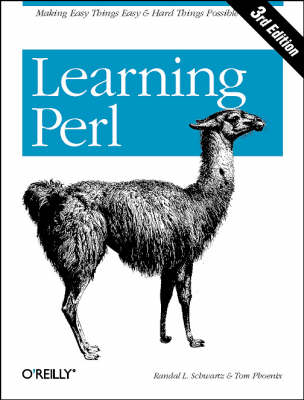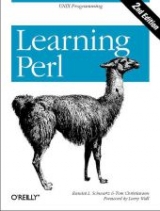
Learning Perl
O'Reilly Media, Inc, USA (Verlag)
978-0-596-00132-2 (ISBN)
- Titel ist leider vergriffen;
keine Neuauflage - Artikel merken
Perl began as a tool for Unix system administrators, used for countless small tasks throughout the workday. It has since blossomed into a full-featured programming language on practically every computing platform, and is used for web programming, database manipulation, XML processing, and (of course) system administration - all the while remaining a tool for the small daily tasks it was designed for. The third edition of "Learning Perl" has not only been updated for Perl 5.6, but has also been rewritten to reflect the needs of programmers learning Perl in the 21st century. It includes an expanded and more gently-paced introduction to regular expressions, new exercises and solutions designed so readers can practise what they've learned while it is still fresh in their minds.
Randal L. Schwartz is a two-decade veteran of the software industry. He is skilled in software design, system administration, security, technical writing, and training. Randal has coauthored the "must-have" standards: Programming Perl, Learning Perl, Learning Perl for Win32 Systems, and Effective Perl Programming, and is a regular columnist for WebTechniques, PerformanceComputing, SysAdmin, and Linux magazines. He is also a frequent contributor to the Perl newsgroups, and has moderated comp.lang.perl.announce since its inception. His offbeat humor and technical mastery have reached legendary proportions worldwide (but he probably started some of those legends himself). Randal's desire to give back to the Perl community inspired him to help create and provide initial funding for The Perl Institute. He is also a founding board member of the Perl Mongers (perl.org), the worldwide Perl grassroots advocacy organization. Since 1985, Randal has owned and operated Stonehenge Consulting Services, Inc. Randal can be reached for comment at merlyn@stonehenge.com or (503) 777-0095, and welcomes questions on Perl and other related topics. Tom Phoenix has been working in the field of education since 1982. After more than thirteen years of dissections, explosions, work with interesting animals, and high-voltage sparks during his work at a science museum, he started teaching Perl classes for Stonehenge Consulting Services, where he's worked since 1996. Since then, he has traveled to many interesting locations, so you might see him soon at a Perl Mongers' meeting. When he has time, he answers questions on Usenet's comp.lang.perl.misc and comp.lang.perl.moderated newsgroups, and contributes to the development and usefulness of Perl. Besides his work with Perl, Perl hackers, and related topics, Tom spends his time on amateur cryptography and speaking Esperanto. His home is in Portland, Oregon.
Preface. 1. Introduction Questions and Answers What Does "Perl" Stand For? How Can I Get Perl? How Do I Make a Perl Program? A Whirlwind Tour of Perl Exercises. 2. Scalar Data What Is Scalar Data? Numbers Strings Perl's Built-in Warnings Scalar Variables Output with print The if Control Structure Getting User Input The chomp Operator The while Control Structure The undef Value The defined Function Exercises. 3. Lists and Arrays Accessing Elements of an Array Special Array Indices List Literals List Assignment Interpolating Arrays into Strings The foreach Control Structure Perl's Favorite Default: Scalar and List Context in List Context Exercises. 4. Subroutines System and User Functions Defining a Subroutine Invoking a Subroutine Return Values Arguments Private Variables in Subroutines The local Operator Variable-length Parameter Lists Notes on Lexical (my) Variables The use strict Pragma The return Operator Exercises. 5. Hashes What Is a Hash? Hash Element Access Hash Functions Typical Use of a Hash Exercises. 6. I/O Basics Input from Standard Input Input from the Diamond Operator The Invocation Arguments Output to Standard Output Formatted Output with printf Exercises. 7. Concepts of Regular Expressions What Are Regular Expressions? Using Simple Patterns A Pattern Test Program Exercises. 8. More About Regular Expressions Character Classes General Quantifiers Anchors Memory Parentheses Precedence Exercises. 9. Using Regular Expressions Matches with m// Option Modifiers The Binding Operator, =~ Interpolating into Patterns The Match Variables Substitutions with s/// The split Operator The join Function Exercises. 10. More Control Structures The unless Control Structure The until Control Structure Expression Modifiers The Naked Block Control Structure The elsif Clause Autoincrement and Autodecrement The for Control Structure Loop Controls Logical Operators Exercise. 11. Filehandles and File Tests What Is a Filehandle? Opening a Filehandle Fatal Errors with die Using Filehandles Reopening a Standard Filehandle File Tests Exercises. 12. Directory Operations Moving Around the Directory Tree Globbing An Alternate Syntax for Globbing Directory Handles Recursive Directory Listing Exercises. 13. Manipulating Files and Directories Removing Files Renaming Files Links and Files Making and Removing Directories Modifying Permissions Changing Ownership Changing Timestamps Using Simple Modules Exercises. 14. Process Management The system Function The exec Function The Environment Variables Using Backquotes to Capture Output Processes as Filehandles Getting Down and Dirty with Fork Sending and Receiving Signals Exercises. 15. Strings and Sorting Finding a Substring with index Manipulating a Substring with substr Formatting Data with sprintf Advanced Sorting Exercises. 16. Simple Databases DBM Files and DBM Hashes Manipulating Data with pack and unpack Fixed-length Random-access Databases Variable-length (Text) Databases Exercises. 17. Some Advanced Perl Techniques Trapping Errors with eval Picking Items from a List with grep Transforming Items from a List with map Unquoted Hash Keys More Powerful Regular Expressions Slices Exercise. A. Exercise Answers. B. Beyond the Llama. Index
| Erscheint lt. Verlag | 21.8.2001 |
|---|---|
| Überarbeitung | Tom Phoenix |
| Verlagsort | Sebastopol |
| Sprache | englisch |
| Maße | 178 x 232 mm |
| Gewicht | 552 g |
| Einbandart | kartoniert |
| Themenwelt | Informatik ► Programmiersprachen / -werkzeuge ► Perl |
| Mathematik / Informatik ► Informatik ► Web / Internet | |
| ISBN-10 | 0-596-00132-0 / 0596001320 |
| ISBN-13 | 978-0-596-00132-2 / 9780596001322 |
| Zustand | Neuware |
| Informationen gemäß Produktsicherheitsverordnung (GPSR) | |
| Haben Sie eine Frage zum Produkt? |
aus dem Bereich

